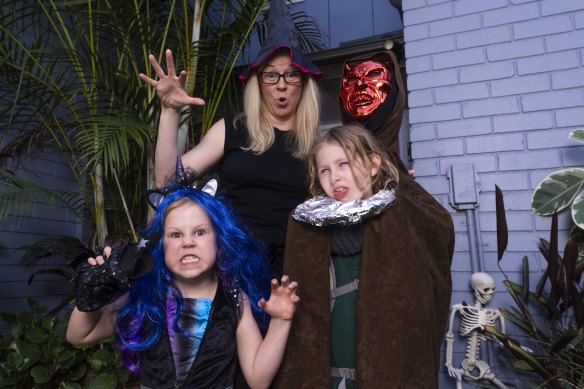
“A couple of streets up from us in Leichhardt, every house participates,” Phillips says. “Our friends moved there and were warned by their neighbours that they should decorate and hand out treats. I’ve taken my kids there every year since they were five and two.”
This hasn’t always been the case. O’Donnell says she would usually only receive random gifts such as 50¢ coins or apples when trick-or-treating as a child because no one in Australia expected any visitors.

Hannah Phillips and children Sofia (left) and Luca trick-or-treat every year in Leichhardt, where Halloween is taken very seriously. Credit: Rhett Wyman
Now Halloween is a multimillion-dollar industry in Australia. According to the Australian Retailers Association and Roy Morgan, an estimated 5.3 million Australians celebrated Halloween last year, spending about $490 million on the season – up 14 per cent since 2022.
So, why has it become so popular?
Carole Cusack, a religious studies historian at the University of Sydney, says Halloween (or “All Hallows Eve”) was initially introduced to Australia via Irish and Scottish migrants. However, much of this folk culture died out by 1900.
Its recent comeback is due to the proliferation of US pop culture, says Dr Rodney Taveira, a lecturer in American Studies from the United States Studies Centre.
While older Australians were more familiar with British content, younger Australians are surrounded by US film, television and social media that often reference Halloween – think Mean Girls and Halloween “boo baskets” on TikTok.
“Halloween provides a shareable event that occurs each year, which means it punctuates not only social lives and their online presence, but also the calendars of retailers who can sell costumes and decorations,” Taveira says.
Keeping safe while having fun
Loading
Parenting expert Genevieve Muir suggests walking your child through certain guidelines before trick-or-treating, such as only knocking on houses that are decorated, or which already have people standing outside with lollies. There isn’t a set age at which children could begin trick-or-treating, she says, so just decide what is right for your family, especially if there are older children.
Finding the right area to trick-or-treat can help. Muir says her Sydney suburb opens a safe zone for children to trick-or-treat between 5pm and 6pm, meaning it’s all over before dark.
Neurodivergent children in particular may struggle with some elements of Halloween, such as interactions with strangers or loud noises. Muir recommends setting up a quiet space ahead of time, and allowing them to forgo dressing up if they’re not interested.
“Support them to feel safe and comfortable, and allow them to join in as much as they want to,” she says. “You should work on this with neurodivergent kids in advance, using visuals and a calendar to let them know when Halloween is coming.”
Ultimately, having a tradition like trick-or-treating can be healthy for children, says parenting expert Dr Justin Coulson. “They give meaning and purpose. They build bonds, create rituals and boost wellbeing.”
Parents should therefore try to trust their children when trick-or-treating, especially once they’re old enough to go without parental supervision.
“We should give our kids a certain level of freedom. Have conversations with them beforehand so that they’re mindful. If you’re still really anxious, you could track them with an AirTag or a phone. But it’s exciting for kids to feel like they’re independent,” Coulson says.
Make the most of your health, relationships, fitness and nutrition with our Live Well newsletter. Get it in your inbox every Monday.




























